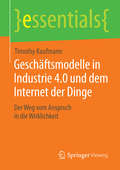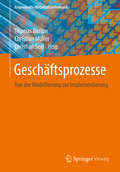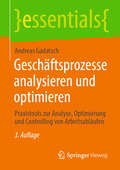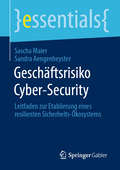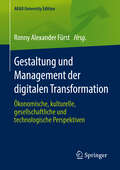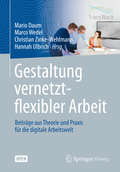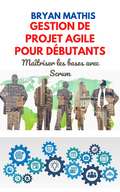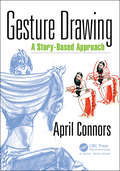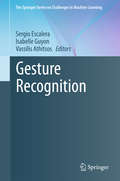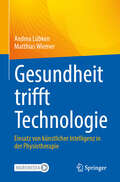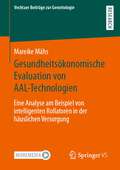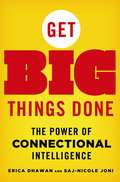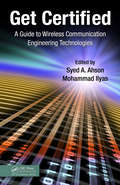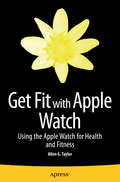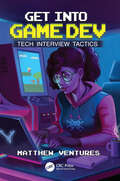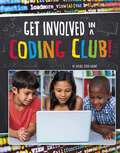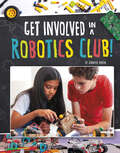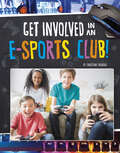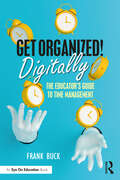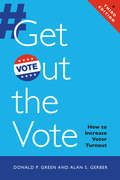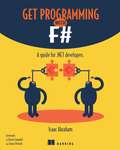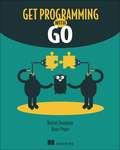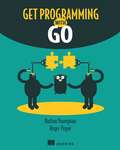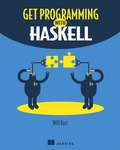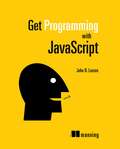- Table View
- List View
Geschäftsmodelle in Industrie 4.0 und dem Internet der Dinge: Der Weg vom Anspruch in die Wirklichkeit (essentials)
by Timothy KaufmannTimothy Kaufmann beschreibt verschiedene Geschäftsmodelle, Kundenbeispiele und geeignete Werkzeuge für die Umsetzung von Industrie 4. 0 und dem Internet der Dinge, die schon heute große Chancen für neue Geschäftsmodelle und die Optimierung von bestehenden bieten. Das vorliegende Essential soll Sie ermutigen, sich jetzt auf den Weg zu begeben!
Geschäftsprozesse
by Thomas Barton Christian Müller Christian SeelDas Buch vermittelt Konzepte, zeigt aktuelle Trends wie agile Methoden, stellt Anwendungsszenarien für die Modellierung und Implementierung von Geschäftsprozessen im Zeitalter der Digitalisierung vor. Das Herausgeberwerk basiert dabei auf Fragestellungen aus der unternehmerischen Praxis. Schwerpunkte sind innovative Analysemethoden, kontextsensitive und wissensintensive Geschäftsprozesse sowie aktuelle Ansätze bei der Umsetzung. Fallstudien runden das Buch ab. Es wendet sich sowohl an Berater und Projektverantwortliche als auch an Studierende und Lehrende.
Geschäftsprozesse analysieren und optimieren: Praxistools zur Analyse, Optimierung und Controlling von Arbeitsabläufen (essentials)
by Andreas GadatschDie 3. Auflage dieses Buchs zeigt konkret auf, was Geschäftsprozessmanagement ist und wie man es nutzen kann. Hierzu werden die zentralen Aspekte erklärt und praxistaugliche Tools anhand von Beispielen vorgestellt. Erleichtern Sie sich die tägliche Praxis der Analyse und Optimierung von Geschäftsprozessen!
Geschäftsrisiko Cyber-Security: Leitfaden zur Etablierung eines resilienten Sicherheits-Ökosystems (essentials)
by Sandra Aengenheyster Sascha MaierNicht erst seit Corona warnen Beobachter und Behörden vor einem zu erwartenden rasanten Anstieg von Cyberkriminalität im privaten sowie beruflichen Umfeld. Die Digitalisierung von Geschäftsmodellen, intensivere Vernetzung von Prozessen, Produkten und Geräten und die zuletzt stärkere Nutzung von Netzwerken und Geräten im Homeoffice sind die Treiber im Kampf für mehr IT-Sicherheit. Das essential wendet sich insbesondere an Geschäftsführer von kleinen und mittelständischen Unternehmen, für die der Aufbau einer wirksamen und nachhaltigen Cyber-Security mit hohem Aufwand verbunden ist. Das Buch ermöglicht ein grundlegendes Verständnis zu potenziellen Bedrohungen der Cyber-Security sowie den Auswirkungen und bietet einen Leitfaden für die Entwicklung eines resilienten Sicherheits-Ökosystems.
Gestaltung und Management der digitalen Transformation: Ökonomische, kulturelle, gesellschaftliche und technologische Perspektiven (AKAD University Edition)
by Ronny Alexander FürstDie Digitalisierung und der sich exponentiell entwickelnde technologische Fortschritt bahnen sich ihren Weg in alle Lebensbereiche einer globalisierten Welt - scheinbar völlig ungeachtet davon, wie dies von einzelnen Individuen und Gesellschaften wahrgenommen und bewertet wird. Manche fühlen sich als Verlierer und haben Ängste, von Robotern und künstlicher Intelligenz ersetzt zu werden, andere entdecken in der Zeitenwende neue Chancen und Perspektiven. Dies wirft zu den technologischen und ökonomischen Herausforderungen der digitalen Transformation zusätzliche kulturelle und gesellschaftliche Fragen auf. Beim 9. AKAD Forum der AKAD University diskutierten Wissenschaftler und Top-Manager das Leitthema „Digitale Transformation = soziale Revolution?“ In diesem Buch werden nun die Fachbeiträge der Experten aus Wirtschaft, Technik, Philosophie und Sprachwissenschaften einem breiteren Publikum vorgestellt. Nach einer theoretischen und praktischen Standortbestimmung werden Konzepte zum Management der digitalen Transformation aufgezeigt, durch die Digitalisierung induzierte soziale Entwicklungen diskutiert und der erforderliche Kompetenzwandel in der digitalen Arbeitswelt sowie neue Anforderungen an die Personalentwicklung beleuchtet und abschließend Zukunftsperspektiven abgeleitet. Lesenswert für alle, die die digitale Transformation verstehen und aktiv gestalten wollen!„Dieses Buch zeigt, wie es Unternehmen gelingt, ihre Geschäftsmodelle auf die digitale Zukunft vorzubereiten und wie dadurch Wettbewerbsvorteile geschaffen und Kunden-Anforderungen besser erfüllt werden können. Die theoretische Fundierung kombiniert mit vielen konkreten, praktischen Hinweisen und Fallbeispielen macht das Buch gleichermaßen lesenswert und nutzbar für Wissenschaftler und Praktiker aus unterschiedlichsten Branchen.“ Bernd Hake, Vorstand Hugo Boss AG
Gestaltung vernetzt-flexibler Arbeit: Beiträge aus Theorie und Praxis für die digitale Arbeitswelt
by Marco Wedel Mario Daum Christian Zinke-Wehlmann Hannah UlbrichDieses Open-Access-Buch umfasst fünfzehn Beiträge aus sechs Verbundvorhaben, die im Rahmen des Förderschwerpunkts „Arbeit in der digitalisierten Welt“ des Bundesministeriums für Bildung und Forschung unterschiedliche Entwicklungen im Transformationsprozess der Arbeitswelt analysieren, konkrete Lösungsansätze entwickeln und wissenschaftlich begleiten und evaluieren. Die Autoren der Beiträge geben Einblicke in ihre Erkenntnisse und die entwickelten Konzepte. Daraus lassen sich für Akteure aus Politik und Wirtschaft entsprechende Handlungsempfehlungen ableiten und es ergeben sich neue Forschungsimpulse für Akteure aus der Wissenschaft.
Gestion de projet Agile pour débutants: Maîtriser les bases avec Scrum
by Bryan MathisL’approche agile de la gestion de projet gagne en popularité car elle permet d’obtenir de meilleurs résultats en moins de temps avec des équipes plus petites que les anciennes méthodes rigides et planifiées. Dans l’économie actuelle basée sur l’information, où Internet génère de nouveaux produits et où les besoins des clients changent du jour au lendemain, Agile aide les entreprises à répondre aux demandes de leurs clients en considérant le changement rapide comme un élément essentiel du processus de développement. Écrit pour les débutants, ce livre explique les concepts Agile en utilisant l’approche Scrum et les intègre dans un cadre cohérent. Au lieu de simplement définir des termes, il présente Agile comme un système vivant et dynamique permettant d’éliminer les fioritures et de revenir à l’essentiel tout en gérant des projets. La première moitié du livre explique le Manifeste d'Agile en détail, à la fois en théorie et en pratique. La seconde partie du livre fournit des explications détaillées sur l’application de Scrum, une méthode Agile connue pour sa simplicité et sa facilité de mise en œuvre. Les petites startups et les entrepreneurs trouveront dans ce livre des conseils pratiques, des encouragements et de l’inspiration, tandis que les équipes de développement des grandes entreprises apprécieront son explication claire et concise de la manière dont les pièces du puzzle Agile s’emboîtent.
Gesture Drawing: A Story-Based Approach
by April ConnorsThis instructional drawing book is intended to guide the reader through a story-telling based approach to gesture drawing, utilizing different techniques and exercises that encourage and develop creative problem solving as it relates to observational studies. This book clearly outlines a work flow and process with a simple exercise program that encourages the artist to ask questions and create work that engages not only their audience but themselves. Rich illustrations are included throughout that depict this workflow and also different drawing and mark-making techniques, and how to apply the exercises throughout the course of the book. Included are video drawing tutorials and examples. Key Features The approach to drawing as explained in the book is broken down into simple, clearly defined concepts. Each chapter outlines a further step in the drawing process, ending with a technique or exercise the reader can then execute to begin applying each concept to their work. Ample amount of illustrations drawn exclusively for this book or taken directly from the author's physical classes to clearly show the reader individual concepts, exercises, techniques, ideas, etc., so the reader may feel comfortable enough to follow the program. Each chapter includes a chapter objective as well as a summary and ample amount of illustrations which relate to the chapter objective. Key Terms will also be highlighted and defined so that they may be referenced throughout the book without causing unnecessary confusion. Companion video tutorials that show the reader different topics and exercises for reference.
Gesture Recognition
by Sergio Escalera Isabelle Guyon Vassilis AthitsosThis book presents a selection of chapters, written by leading international researchers, related to the automatic analysis of gestures from still images and multi-modal RGB-Depth image sequences. It offers a comprehensive review of vision-based approaches for supervised gesture recognition methods that have been validated by various challenges. Several aspects of gesture recognition are reviewed, including data acquisition from different sources, feature extraction, learning, and recognition of gestures.
Gesundheit trifft Technologie: Einsatz von künstlicher Intelligenz in der Physiotherapie
by Andrea Lübken Matthias WiemerDieses Fachbuch hilft Physiotherapeut*innen und Praxisinhaber*innen dabei, Künstliche Intelligenz (KI) in ihrem praktischen Alltag zu etablieren. Mit verständlichen Erklärungen und Anwendungsbeispielen zeigt das Buch, wie KI die Bewegungsanalyse, Telemedizin, Robotik und viele weitere Bereiche der Physiotherapie unterstützen kann. Erfahren Sie, wie Sie technologische Innovationen sinnvoll integrieren, um Ihre Arbeit zu erleichtern und die Patientenversorgung zu verbessern, ohne dabei den menschlichen Kontakt als Herzstück der Therapie zu verlieren. Aus dem Inhalt: Chancen und Potenziale der KI in der Physiotherapie: der Einsatz von KI in den verschiedenen Fachgebieten, wie Neurologie, Orthopädie, Geriatrie und Pädiatrie, technologische Grundlagen und Anwendungen: Bewegungsanalysen, Exoskelette, Wearables und die Anwendung von Tools und Apps im Praxisalltag, die Rolle des Menschen: Autonomie und Selbstmanagement sowie Ängste und Vertrauensbildung, lebenslanges Lernen, Ethik und Inklusion: ethische und rechtliche Herausforderungen, Datenschutz, Barrierefreiheit, inklusive Technologien, plus: übersichtliche Auflistung verschiedener Tools und Geräte für die Physiotherapie zum Download.
Gesundheitsökonomische Evaluation von AAL-Technologien: Eine Analyse am Beispiel von intelligenten Rollatoren in der häuslichen Versorgung (Vechtaer Beiträge zur Gerontologie)
by Mareike MähsUm die Informationsbasis über AAL-Technologien zu erhöhen, wird Wissen über die Effektivität, den Nutzen und die Kosten dieser Technologien benötigt. Es fehlen jedoch gerade für AAL-Technologien qualitativ hochwertige gesundheitsökonomische Evaluationsstudien. Die vorliegende Arbeit hat deshalb das Ziel, gesundheitsökonomische Evaluationsverfahren hinsichtlich ihres Einsatzes zur Abschätzung der Wirksamkeit und Wirtschaftlichkeit von AAL-Technologien zu untersuchen und eine geeignete Vorgehensweise zur Evaluationen von AAL-Technologien am Beispiel von intelligenten Rollatoren aufzuzeigen. Mareike Mähs zeigt, dass eine gesundheitsökonomische Evaluation von AAL-Technologien mit spezifischen Herausforderungen einhergeht. Dementsprechend sind vorhandene Verfahren an die Charakteristika der Technologie und ihrer Nutzerinnen sowie Nutzer anzupassen bzw. alternative Verfahren zu wählen. Aus diesem Grund wird ein Framework entwickelt, das eine Orientierung für eine strukturierte Vorgehensweise zur entwicklungsbegleitenden Evaluation von AAL-Technologien am Beispiel von intelligenten Rollatoren entlang deren Lebenszyklus bietet.
Get Big Things Done: The Power of Connectional Intelligence
by Saj-Nicole Joni Erica DhawanConnectional Intelligence unlocks the 21st-century secret to getting "big things done," regardless of who you are, where you live, or what you do.We typically associate success and leadership with smarts, passion and luck. But in today's hypercompetitive world, even those gifts aren't enough. Get Big Things Done argues that the game changer is a thoroughly modern skill called Connectional Intelligence. Virtually anyone can maximize his or her potential, and achieve breakthrough performance, by developing this crucial ability. So, what is it? Put simply, Connectional Intelligence is the ability to combine knowledge, ambition and human capital, forging connections on a global scale that create unprecedented value and meaning. As radical a concept as Emotional Intelligence was in the 90s, Connectional Intelligence is changing everything from business and sports to academics, health and politics by quickly, efficiently and creatively helping people enlist supporters, drive innovation, develop strategies and implement solutions to big problems.Can a small-town pumpkin grower affect the global food crisis? A Fortune 500 executive change her company's outdated culture through video storytelling? A hip-hop artist launch an international happiness movement? Or a scientist use virtual reality games to lower pain for burn victims? The answer, you'll read, is a resounding yes. Each of these individuals is using Connectional Intelligence to become a power player to get big things done.Erica Dhawan and Saj-nicole Joni's Get Big Things Done unlocks the secrets of how the world's movers and shakers use Connectional Intelligence to achieve their personal and professional goals--no matter how ambitious.
Get Certified: A Guide to Wireless Communication Engineering Technologies
by Mohammad Ilyas Syed A. AhsonThe Institute of Electrical and Electronics Engineers (IEEE) Communications Society designed the IEEE wireless communication engineering technologies (WCET) certification program to address the wireless industry's growing need for communications professionals with practical problem-solving skills in real-world situations. Individuals who achieve th
Get Fit with Apple Watch
by Allen TaylorGet Fit with Apple Watch is the concise introduction to the amazing new Apple Watch. It's the first book specifically focused on the Apple Watch's most important function: health and fitness.This book is for you if you are interested in health and are willing to make small lifestyle adjustments in order to enhance health and well-being. This book is also for you if you are a dedicated health junkie who already exercises on a regular basis and follows a healthy diet. The Apple Watch includes fitness apps that you can access right on your wrist while you are exercising, for instant feedback on how you are doing.You will learn how to use the Watch to avoid sitting for too long, to register a healthy amount of body movement every day, and how to get the most out of more strenuous exercise activities. All fitness and exercise-related built-in apps will be covered in detail, as well as leading third party health and fitness apps that have been specifically tailored to work with the Watch.Part I plus two appendixes give readers just what they need to know to understand all functionality of the Apple Watch to set up their Apple Watch, and what third-party apps are available (at time of publication). It's a great mini-book that will be appeal to readers who don't feel the need to buy an entire standalone introduction to the Apple Watch.Part II (the majority of the book) clearly explains the Apple Watch's fitness and health-tracking functions, but goes well beyond this by showing readers different ways to integrate these functions into their daily lives, regular workout routines, and with their iPhone and the leading third-party health and fitness apps. Plus, there's an entire chapter devoted to the Apple Watch Research Kit, explaining the benefits of the associated medical research apps and how users can participate in these world-changing programs, should they choose to.Veteran technology author Allen Taylor is also a participant in the Apple Watch Research Kit study in cardiovascular fitness conducted by Stanford University.
Get Into Game Dev: Tech Interview Tactics
by Matthew VenturesGet Into Game Dev: Tech Interview Tactics is a crash-course on how to pass a game development technical interview. It’s designed to guide intermediate and experienced coders through the depth and rigor necessary to land some of the most highly sought-after roles within interactive media.Unlike generic interview-prep books, GIGD maintains a laser-focus on game development to directly prepare candidates for roles like technical designer and gameplay engineer. Topics include 3D maths, programming fundamentals, and software design patterns. The author provides high quality instruction and practice problems based on his experience as a professional instructor and developer.Key Features: Includes an extensive set of practice questions taken from interviews of leading game development studios. Synthesizes coding and maths fundamentals into focused instruction, directly applicable to game development. Culminates in a rigorous practice test, designed to identify a reader’s weaknesses and guide them along the path to mastery. Uses a variety of mnemonics to assist readers in memorizing subject matter. Provides example worked solutions for readers to compare against their own problem-solving approaches. This book does not teach game development. Instead, it provides knowledge and instruction for a developer to achieve the technical mastery necessary to become a professional game developer.
Get Involved in a Coding Club! (Join the Club)
by Rachel Ziter-GrantCan't get enough of coding? If so, a coding club might be the right fit for you! Find out what it takes to join a coding club or start your own, including information on membership, meetings, and activities. Together, you and your fellow members can participate, create, and most importantly, have fun. Take the plunge, join the club, and get involved!
Get Involved in a Robotics Club! (Join the Club)
by Jennifer MasonWild about robotics? If so, a robotics club might be the right fit for you! Find out what it takes to join a robotics club or start your own, including information on membership, meetings, and activities. Together, you and your fellow members can participate, create, and most importantly, have fun. Take the plunge, join the club, and get involved!
Get Involved in an E-sports Club! (Join the Club)
by Christina MajaskiExcited about eSports? If so, an eSports club might be the right fit for you! Find out what it takes to join an eSports club or start your own, including information on membership, meetings, and activities. Together, you and your fellow members can participate, create, and most importantly, have fun. Take the plunge, join the club, and get involved!
Get Organized Digitally!: The Educator’s Guide to Time Management
by Frank BuckIn today’s world, we’re often overwhelmed by our digital devices and the volume of available digital information. Get Organized Digitally! outlines a complete digital organizational system for the busy educator and helps you harness the power of technology to save time. This book is your go-to source, presenting the "nuts and bolts" of exactly how to make technology work for you in both your personal and professional life. Special features of Get Organized Digitally!: Details of how to get started with the best digital organizational tools available today. Principles of digital organization that make all the components of your system work together. Stories that inspire and show how technology can make our lives easier. Time is the most precious resource we have; managing it well leads to greater productivity and less stress. Get Organized Digitally! shows educators how to harness the power of technology to spend time on what matters most—your school and your students.
Get Out the Vote: How to Increase Voter Turnout
by Donald P. Green Alan S. GerberThe most important element in every election is getting voters to the polls-these get-out-the-vote (GOTV) efforts make the difference between winning and losing office. With the first two editions of Get Out the Vote, Donald P. Green and Alan S. Gerber broke ground by introducing a new scientific approach to the challenge of voter mobilization that profoundly influenced how campaigns operate. Get Out the Vote has become the reference text for those who manage campaigns and study voter mobilization.In this expanded and updated edition, Green and Gerber incorporate data from more than 100 new studies, which shed new light on the costeffectiveness and efficiency of various campaign tactics, including door-to-door canvassing, email, direct mail, and telephone calls. Two new chapters focus on the effectiveness of registration drives and messaging tactics. The new Get Out the Vote will be available as the country gears up for the 2016 presidential campaign. This readable, practical guide on voter mobilization is sure to be an important resource for consultants, candidates, and grassroots organizations, as well as a valuable teaching tool in courses on campaigns and elections.
Get Programming with F#: A guide for .NET developers
by Isaac AbrahamSummary Get Programming with F#: A guide for .NET developers teaches F# through 43 example-based lessons with built-in exercises so you can learn the only way that really works: by practicing. The book upgrades your .NET skills with a touch of functional programming in F#. You'll pick up core FP principles and learn techniques for iron-clad reliability and crystal clarity. You'll discover productivity techniques for coding F# in Visual Studio, functional design, and integrating functional and OO code. Purchase of the print book includes a free eBook in PDF, Kindle, and ePub formats from Manning Publications. About the Technology Your .NET applications need to be good for the long haul. F#'s unique blend of functional and imperative programming is perfect for writing code that performs flawlessly now and keeps running as your needs grow and change. It takes a little practice to master F#'s functional-first style, so you may as well get programming! What's Inside Learn how to write bug-free programs Turn tedious common tasks into quick and easy ones Use minimal code to work with JSON, CSV, XML, and HTML data Integrate F# with your existing C# and VB.NET applications Create web-enabled applications About the Reader Written for intermediate C# and Visual Basic .NET developers. No experience with F# is assumed. Table of Contents Unit 1 - F# AND VISUAL STUDIO Lesson 1 - The Visual Studio experience Lesson 2 - Creating your first F# program Lesson 3 - The REPL-changing how we develop Unit 2 - HELLO F# Lesson 4 - Saying a little, doing a lot Lesson 5 - Trusting the compiler Lesson 6 - Working with immutable data Lesson 7 - Expressions and statements Lesson 8 Capstone 1 Unit 3 - TYPES AND FUNCTIONS Lesson 9 - Shaping data with tuples Lesson 10 - Shaping data with records Lesson 11 - Building composable functions Lesson 12 - Organizing code without classes Lesson 13 - Achieving code reuse in F# Lesson 14 - Capstone 2 Unit 4 - COLLECTIONS IN F# Lesson 15 - Working with collections in F# Lesson 16 - Useful collection functions Lesson 17 - Maps, dictionaries, and sets Lesson 18 - Folding your way to success Lesson 19 - Capstone 3 Unit 5 - THE PIT OF SUCCESS WITH THE F# TYPE SYSTEM Lesson 20 - Program flow in F# Lesson 21 - Modeling relationships in F# Lesson 22 - Fixing the billion-dollar mistake Lesson 23 - Business rules as code Lesson 24 - Capstone 4 Unit 6 - LIVING ON THE .NET PLATFORM Lesson 25 - Consuming C# from F# Lesson 26 - Working with NuGet packages Lesson 27 - Exposing F# types and functionsto C# Lesson 28 - Architecting hybrid language applications Lesson 29 - Capstone 5 Unit 7 - WORKING WITH DATA Lesson 30 - Introducing type providers Lesson 31 - Building schemas from live data Lesson 32 - Working with SQL Lesson 33 - Creating type provider-backed APIs Lesson 34 - Using type providers in the real world Lesson 35 - Capstone 6 Unit 8 - WEB PROGRAMMING Lesson 36 - Asynchronous workflows Lesson 37 - Exposing data over HTTP Lesson 38 - Consuming HTTP data Lesson 39 - Capstone 7 Unit 9 - UNIT TESTING Lesson 40 - Unit testing in F# Lesson 41 - Property-based testing in F# Lesson 42 - Web testing Lesson 43 - Capstone 8 Unit 10 - WHERE NEXT? Appendix A - The F# community Appendix B - F# in my organization Appendix C - Must-visit F# resources Appendix D - Must-have F# libraries Appendix E - Other F# language feature
Get Programming with Go
by Nathan Youngman Roger PeppeHobbyists, newcomers, and professionals alike can benefit from a fast, modern language; all you need is the right resource! Get Programming with Go provides a hands-on introduction to Go language fundamentals, serving as a solid foundation for your future programming projects. You'll master Go syntax, work with types and functions, and explore bigger ideas like state and concurrency, with plenty of exercises to lock in what you learn.
Get Programming with Go
by Nathan Youngman Roger PeppeSummaryGet Programming with Go introduces you to the powerful Go language without confusing jargon or high-level theory. By working through 32 quick-fire lessons, you'll quickly pick up the basics of the innovative Go programming language! Purchase of the print book includes a free eBook in PDF, Kindle, and ePub formats from Manning Publications.About the TechnologyGo is a small programming language designed by Google to tackle big problems. Large projects mean large teams with people of varying levels of experience. Go offers a small, yet capable, language that can be understood and used by anyone, no matter their experience.About the BookHobbyists, newcomers, and professionals alike can benefit from a fast, modern language; all you need is the right resource! Get Programming with Go provides a hands-on introduction to Go language fundamentals, serving as a solid foundation for your future programming projects. You'll master Go syntax, work with types and functions, and explore bigger ideas like state and concurrency, with plenty of exercises to lock in what you learn.What's insideLanguage concepts like slices, interfaces, pointers, and concurrencySeven capstone projects featuring spacefaring gophers, Mars rovers, ciphers, and simulationsAll examples run in the Go Playground - no installation required!About the ReaderThis book is for anyone familiar with computer programming, as well as anyone with the desire to learn.About the AuthorNathan Youngman organizes the Edmonton Go meetup and is a mentor with Canada Learning Code. Roger Peppé contributes to Go and runs the Newcastle upon Tyne Go meetup.Table of ContentsUnit 0 - GETTING STARTEDGet ready, get set, Go Unit 1 - IMPERATIVE PROGRAMMINGA glorified calculator Loops and branches Variable scope Capstone: Ticket to MarsUnit 2 - TYPESReal numbers Whole numbers Big numbers Multilingual text Converting between types Capstone: The Vigenère cipher Unit 3 - BUILDING BLOCKSFunctions Methods First-class functions Capstone: Temperature tables Unit 4 - COLLECTIONSArrayed in splendor Slices: Windows into arrays A bigger slice The ever-versatile map Capstone: A slice of life Unit 5 - STATE AND BEHAVIORA little structure Go's got no class Composition and forwarding Interfaces Capstone: Martian animal sanctuary Unit 6 - DOWN THE GOPHER HOLEA few pointers Much ado about nil To err is human Capstone: Sudoku rules Unit 7 - CONCURRENT PROGRAMMINGGoroutines and concurrency Concurrent state Capstone: Life on Mars
Get Programming with Haskell
by Will KurtSummary Get Programming with Haskell leads you through short lessons, examples, and exercises designed to make Haskell your own. It has crystal-clear illustrations and guided practice. You will write and test dozens of interesting programs and dive into custom Haskell modules. You will gain a new perspective on programming plus the practical ability to use Haskell in the everyday world. (The 80 IQ points: not guaranteed.) Purchase of the print book includes a free eBook in PDF, Kindle, and ePub formats from Manning Publications. About the Technology Programming languages often differ only around the edges—a few keywords, libraries, or platform choices. Haskell gives you an entirely new point of view. To the software pioneer Alan Kay, a change in perspective can be worth 80 IQ points and Haskellers agree on the dramatic benefits of thinking the Haskell way—thinking functionally, with type safety, mathematical certainty, and more. In this hands-on book, that's exactly what you'll learn to do. What's Inside Thinking in Haskell Functional programming basics Programming in types Real-world applications for Haskell About the Reader Written for readers who know one or more programming languages. Table of Contents Lesson 1 Getting started with Haskell Unit 1 - FOUNDATIONS OF FUNCTIONAL PROGRAMMING Lesson 2 Functions and functional programming Lesson 3 Lambda functions and lexical scope Lesson 4 First-class functions Lesson 5 Closures and partial application Lesson 6 Lists Lesson 7 Rules for recursion and pattern matching Lesson 8 Writing recursive functions Lesson 9 Higher-order functions Lesson 10 Capstone: Functional object-oriented programming with robots! Unit 2 - INTRODUCING TYPES Lesson 11 Type basics Lesson 12 Creating your own types Lesson 13 Type classes Lesson 14 Using type classes Lesson 15 Capstone: Secret messages! Unit 3 - PROGRAMMING IN TYPES Lesson 16 Creating types with "and" and "or" Lesson 17 Design by composition—Semigroups and Monoids Lesson 18 Parameterized types Lesson 19 The Maybe type: dealing with missing values Lesson 20 Capstone: Time series Unit 4 - IO IN HASKELL Lesson 21 Hello World!—introducing IO types Lesson 22 Interacting with the command line and lazy I/O Lesson 23 Working with text and Unicode Lesson 24 Working with files Lesson 25 Working with binary data Lesson 26 Capstone: Processing binary files and book data Unit 5 - WORKING WITH TYPE IN A CONTEXT Lesson 27 The Functor type class Lesson 28 A peek at the Applicative type class: using functions in a context Lesson 29 Lists as context: a deeper look at the Applicative type class Lesson 30 Introducing the Monad type class Lesson 31 Making Monads easier with donotation Lesson 32 The list monad and list comprehensions Lesson 33 Capstone: SQL-like queries in Haskell Unit 6 - ORGANIZING CODE AND BUILDING PROJECTS Lesson 34 Organizing Haskell code with modules Lesson 35 Building projects with stack Lesson 36 Property testing with QuickCheck Lesson 37 Capstone: Building a prime-number library Unit 7 - PRACTICAL HASKELL Lesson 38 Errors in Haskell and the Either type Lesson 39 Making HTTP requests in Haskell Lesson 40 Working with JSON data by using Aeson Lesson 41 Using databases in Haskell Lesson 42 Efficient, stateful arrays in Haskell Afterword - What's next? Appendix - Sample answers to exercise
Get Programming with JavaScript
by John LarsenSummaryGet Programming with JavaScript is a hands-on introduction to programming for readers who have never programmed. You'll be writing your own web apps, games, and programs in no time! Foreword by Remy Sharp.Purchase of the print book includes a free eBook in PDF, Kindle, and ePub formats from Manning Publications.About the BookAre you ready to start writing your own web apps, games, and programs? You’re in the right place! Get Programming with JavaScript is a hands-on introduction to programming for readers who have never written a line of code. Since you’re just getting started, this friendly book offers you lots of examples backed by careful explanations. As you go along, you’ll find exercises to check your understanding and plenty of opportunities to practice your new skills. You don’t need anything special to follow the examples—just the text editor and web browser already installed on your computer. We even give you links to working online code so you can see how everything should look live on your screen.What’s InsideAll the basics—objects, functions, responding to users, and moreThink like a coder and design your own programsCreate a text-based adventure gameEnhance web pages with JavaScriptRun your programs in a web browserFour bonus chapters available onlineAbout the ReaderNo experience required! All you need is a web browser and an internet connection.About the AuthorJohn Larsen is a mathematics and computing teacher with an interest in educational research. He has an MA in mathematics and an MSc in information technology. He started programming in 1982, writing simple programs for teaching mathematics in 1993, building websites in 2001, and developing data-driven web-based applications for education in 2006.Table of ContentsPART 1 CORE CONCEPTS ON THE CONSOLEProgramming, JavaScript, and JS BinVariables: storing data in your programObjects: grouping your dataFunctions: code on demandArguments: passing data to functionsReturn values: getting data from functionsObject arguments: functions working with objectsArrays: putting data into listsConstructors: building objects with functionsBracket notation: flexible property namesPART 2 ORGANIZING YOUR PROGRAMSScope: hiding informationConditions: choosing code to runModules: breaking a program into piecesModels: working with dataViews: displaying dataControllers: linking models and viewsPART 3 JAVASCRIPT IN THE BROWSERHTML: building web pagesControls: getting user inputTemplates: filling placeholders with dataXHR: loading dataConclusion: get programming with JavaScriptBONUS ONLINE CHAPTERSNode: running JavaScript outside the browserExpress: building an APIPolling: repeating requests with XHRSocket.IO: real-time messaging
